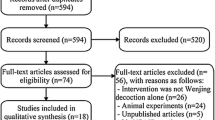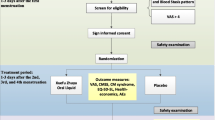Abstract
Background
Primary dysmenorrhea (PD) is the most common complaint associated with menstruation and affects up to three-quarters of women at some stage of their reproductive life. In Chinese medicine, navel therapy, treatment provided at Shenque (CV 8), is used as a treatment option for PD.
Objective
To evaluate the effect of navel therapy on pain relief and quality of life in women with PD, compared with Western medicine (WM).
Methods
China National Knowledge Infrastructure (CNKI), Chinese Scientific Journal Database (VIP), SinoMed and Wanfang Database, MEDLINE, the Cochrane Library, Embase, Web of Science, and the International Clinical Trial Registry of the U.S. National Institutes of Health were searched from their inceptions to April 1, 2021. Randomized controlled trials (RCTs) assessing therapeutic effects of navel therapy on PD were eligible for inclusion. RevMan 5.4 software was used for data analyses. The certainty of the evidence was assessed using the online GRADEpro tool.
Results
Totally 24 RCTs involving 2,614 participants were identified. Interventions applied to acupuncture point CV 8 included: herbal patching, moxibustion or combined navel therapy (using at least 2 types of stimulation). Compared to placebo, there was a significant effect in favor of navel therapy on reducing overall menstrual symptom scores at the end of treatment [mean difference: −0.82, 95% confidence interval (CI): −1.00 to −0.64, n=90; 1 RCT]. As compared with Western medicine, navel therapy had a superior effect on pain intensity as assessed by Visual Analogue Scale at the end of treatment [standardized mean difference (SMD): −0.64, 95% CI: −1.22 to −0.06, I2=80%, n=262; 3 RCTs]; on symptom resolution rate at 3-month follow-up (risk ratio: 1.94, 95% CI: 1.47 to 2.56, n=1527, I2=38%; 13 RCTs); and on global menstrual symptoms score at the end of treatment (SMD: −0.67, 95% CI: −0.90 to −0.45, I2=63%, n=990; 12 RCTs). Subgroup analyses showed either a better or an equivalent effect comparing navel therapy with Western medicine. No major adverse events were reported. The methodological quality of included trials was poor overall.
Conclusions
Navel therapy appears to be more effective than Western medicine in decreasing menstrual pain and improving overall symptoms of PD. However, these findings need to be confirmed by well-designed clinical trials with adequate sample size (Systematic review registration at PROSPERO, No. CRD42021240350)
Similar content being viewed by others
Availability of Data and Materials
All data generated or analyzed during this study are included in this published article.
References
Burnett M, Lemyre M. No. 345-primary dysmenorrhea consensus guideline. J Obstet Gynaecol Can 2017;39:585–595.
Iacovides S, Avidon I, Baker FC. What we know about primary dysmenorrhea today: a critical review. Hum Reprod Update 2015;21:762–778.
Omidvar S, Bakouei F, Amiri FN, Begum K. Primary dysmenorrhea and menstrual symptoms in Indian female students: prevalence, impact, and management. Glob J Health Sci 2016;8:53632.
De Sanctis V, Soliman AT, Elsedfy H, Soliman NA, Soliman R, El Kholy M. Dysmenorrhea in adolescents and young adults: a review in different country. Acta Biomed 2016;87:233–246.
Guimarães I, Póvoa AM. Primary dysmenorrhea: assessment and treatment. Rev Bras Ginecol Obstet 2020;42:501–507.
Ziaei S, Zakeri M, Kazemnejad A. A randomized controlled trial of vitamin E in the treatment of primary dysmenorrhea. BJOG 2005;112:466–469.
Proctor ML, Murphy PA. Herbal, and dietary therapies for primary and secondary dysmenorrhoea. Cochrane Database Syst Rev 2001: CD002124.
Chen MR, Zhao J, Fu SF, Yu JQ, Zhang X, Zhang QY, et al. Clinical practice of Chinese medicine navel therapy for chronic diarrhea: a literature review. J Gastroenterol Hepatol (Chin) 2019;34:643–649.
Gao SZ, ed. A complete collection of umbilical therapy of traditional Chinese medicine. Jinan: Jinan Press; 1992:23–29.
Ma J, ed. Annotations on ancient medical texts of Mawangdui Tomb. Changsha: Hunan Science and Technology Press;1992:109.
Chien YW. Navel absorption: transdermal bioavailability of testosterone. J Pharm Sci 1984;73:283–285.
Yang J. Therapeutic observation of application at Shenque (CV 8) for primary dysmenorrhea due to blood stagnation [dissertation]. Guangzhou: Guangzhou University of Chinese Medicine; 2017.
Cao XM, Zhang LQ. 43 cases of primary dysmenorrheal treated by navel therapy. J Exter Therapy Tradit Chin Med (Chin) 2011;20:20–21.
Huang JX, Zhou K. Therapeutic observation on the curative effect of acupoint application combined with Wenjing Zhitong prescription in treating primary dysmenorrhea of cold-damp coagulation type. J Sichuan Tradit Chin Med (Chin) 2019;37:168–170.
Miao FR. The research on the relationship and the influence of prostaglandin and hemorheology indicators between moxibustion quantity and clinical efficacy on cold-damp type primary dysmenorrhea which treated by drug-paste interposed moxibustion [dissertation]. Nanning: Guangxi University of Chinese Medicine; 2011.
Sun Z, Wang Q, Li J, Su CX. Systematic review on intervention effect of compressing umbilical with Chinese herbal for primary dysmenorrheal patients. Chin Nurs Res (Chin) 2014;28:506–510.
Bian Y. Treatment of 60 cases of primary dysmenorrhea in female college students by umbilical application of Evodia rutaecarpa. Chin Med Modern Distance Edu China (Chin) 2014;12:37.
ICH. Clinical safety data management: definitions and standards for expedited Reporting 1999. Available at: http://www.ich.org/fileadmin/Public_Web_Site/ICH_Products/Guidelines/Efficacy/E2A/Step4/E2A_Guideline.pdf.
Higgins JP, Altman DG, Gøtzsche PC, Jüni P, Moher D, Oxman AD, et al. The Cochrane Collaboration’s tool for assessing risk of bias in randomized trials. BMJ 2011;343:d5928.
Higgins JPT, Thomas J, Chandler J, Cumpston M, Li T, Page MJ, et al. Cochrane handbook for systematic reviews of interventions. version 6.1 (updated September 2020). Cochrane 2020. Available at: www.training.cochrane.org/handbook.
Deeks JJ, Higgins JPT, Altman DG, eds. Chapter 10: Analyzing data and undertaking meta-analyses. In: Higgins JPT, Thomas J, Chandler J, Cumpston M, Li T, Page MJ, et al, eds. Cochrane handbook for systematic reviews of interventions. version 6.2 (updated February 2021). Cochrane 2021. Available at: www.training.cochrane.org/handbook.
Guyatt GH, Oxman AD, Kunz R, Vist GE, Falck-Ytter Y, Schünemann HJ, et al. What is “quality of evidence” and why is it important to clinicians? BMJ 2008;336:995–998.
Zhu Y, Ji L, Chen RL, Miao FR. Efficacy observation of primary dysmenorrhea treated with isolated-herbal moxibustion on Shenque (CV 8). Chin Acupunct Moxibust (Chin) 2010;30:453–455.
Zhu Y, Ji L, Miao FR. The influence of hemorrheology during monthly period on primary dysmenorrhea cases treated by drug-paste interposed moxibustion on Shenque (CV 8). Liaoning J Tradit Chin Med (Chin) 2011;38:548–550.
Ji L, Chen RL, Zhou LJ, Lin NQ, Zhou GJ, Zhu Y. The influence of different amount of moxibustion on IL-4, IL-10 and IFN-γ of cold and coagulation-type dysmenorrhea. J Clin Acupunct Moxibust (Chin) 2014;4–6,7.
Chen RL, Ji L, Miao FR, Deng PY, Zhou LJ, Zhu Y. Clinical effect of medicine-separated moxibustion on primary dysmenorrhea and its influence on PGF2α/PGE2. J Liaoning Univer Tradit Chin Med (Chin) 2013;15:19–21.
Chen LR, Lin NQ, Dushi CC, Zhou LJ, Ji L, Miao FR, et al. Influence of herb-partitioned moxibustion with cytokine expression on primary dysmenorrhea. J Sichuan Tradit Chin Med (Chin) 2014;32:150–153.
Wei QB, Zhou YD, Zhou P, Zhang SC. Efficacy of prostaglandin expression of primary dysmenorrhea with Chinese medicine plaster on navel. China Pharmacist (Chin) 2007;10:958–959.
Cai Y, Zeng GF, Liu XH. Traditional Chinese medicine paste to treat primary dysmenorrhea. China Med Pharm (Chin) 2011;1:29–30.
Chen SL, Huang SN, He JR. The observation on the curative effect of traditional Chinese medicine moxibustion on Shenque acupoint in treating primary dysmenorrhea of cold coagulation and blood stasis type. Inner Mongol J Tradit Chin Med (Chin) 2013;32:68–69.
Chen ZT, Zhao HY, Wang CS. The observation on curative effect of Shenque acupoint application on dysmenorrhea. Hebei J Tradit Chin Med (Chin) 2007;29:73.
Chen YR. Clinical and experimental study on cold stasis type primary dysmenorrhea treated with moxibustion Shenque point [dissteration]. Guangzhou: Guangzhou University of Chinese Medicine; 2016.
Gu DM. Clinical experience of treating primary dysmenorrhea with Chinese medicine umbilical application combined with Western medicine. China Pract Med (Chin) 2015;33:191–192.
Huang SN, Chen SL, Xie QX. 50 cases of primary dysmenorrhea treated by Chinese medicine moxibustion at Shenque point. Chin Med Modern Distance Edu China (Chin) 2011;9:51–52.
Lin NQ. Study on special function of Shengque Guanyuan Sanyinjiao which were medicine-separated moxibusted on to primary dysmenorrheal [dissertation]. Nanning: Guangxi University of Chinese Medicine; 2014.
Wei H. Clinical observation on primary dysmenorrhea treated by integrated traditional Chinese and Western medicine. Med Aesthetics Cosmetol (Chin) 2015:168.
Wu HY, Li SL. The influence of Chinese medicine umbilical application combined with warm acupuncture on dysmenorrhea with cold coagulation and blood stasis and its effect on PGE2 and PGF2α in peripheral blood. Modern J Integr Tradit Chin West Med (Chin) 2016;25:2896–2899.
Xia FL. Treatment of primary dysmenorrhea with cold coagulation and stasis by drug separation moxibustion umbilical therapy. J Pract Gynecol Endocrinol (Chin) 2018;5:150–151.
Ye L, Duo LY, Wu KL. Efficacy and mechanisms of Wentong Powder with Shenque acupoint application in the treatment of primary dysmenorrhea with syndrome of blood stasis due to coagulated cold. Shanghai J Tradit Chin Med (Chin) 2018;52:51–54.
Zhang HT, Zhang SY, Xie ZW, Shen WZ. Clinical effects of warming channel and expelling cold umbilical stick on treating primary dysmenorrhea of cold-damp stagnation type. Liaoning J Tradit Chin Med (Chin) 2013;40:2478–2480.
Zhang XL, Ma XM. Clinical study on acupoint application for pain in patients with primary dysmenorrhea. Shanghai J Acupunct Moxibust (Chin) 2019;38:1248–1252.
Wickström K, Edelstam G. Minimal clinically important difference for pain on the VAS scale and the relation to quality of life in women with endometriosis. Sex Reprod Health 2017;13:35–40.
Acknowledgements
The authors greatly thank Dr. LIN Ke-ke from School of Nursing, Beijing University of Chinese Medicine, for her invaluable assistance with feedback on the manuscript; and GONG Yi for giving her advices on inclusion criteria (PICO), and subgroups, from the perspective of clinician. The authors also greatly thank the reviewers for feedback and comments on this paper.
Author information
Authors and Affiliations
Contributions
Liu JP and Yan LJ conceived and designed the review. Yan LJ, Fang M and Shen C were responsible for the searching, screening, and selection of trials. Fang M, Wang D and Yan LJ participated in the data extraction. Yan LJ and Zhu SJ were responsible for the risk of bias assessment. Yan LJ performed statistical analysis; Yan LJ and Liang SB completed certainty assessment of evidence using GRADE. Yan LJ drafted the manuscript. Yang D and Wang D assisted the writing of the manuscript. Fang M and Wang ZJ completed the PRISMA checklist. Liu JP, Robinson N, Hu XY and Wang ZJ were involved in critically revising the manuscript. All authors have read, revised, and approved the manuscript, including the authorship list.
Corresponding author
Additional information
Conflict of Interest
The authors declare that the research was conducted in the absence of any commercial or financial relationships that could be construed as a potential conflict of interest.
Supported by Innovation Team and Talents Cultivation Program of National Administration of Traditional Chinese Medicine (No. ZYYCXTD-C-202006), Longitudinal Development Funding of Beijing University of Chinese Medicine (No. 2021-ZXFZJJ-016), the National Institute for Health Research (No. SPCR-143) Shanxi Provincial Health Commission Project (No. 2020050)
Electronic supplementary material
Rights and permissions
About this article
Cite this article
Yan, Lj., Fang, M., Zhu, SJ. et al. Effectiveness and Safety of Chinese Medicine at Shenque (CV 8) for Primary Dysmenorrhea: A Systematic Review and Meta-Analysis of Randomized Controlled Trials. Chin. J. Integr. Med. 29, 341–352 (2023). https://doi.org/10.1007/s11655-022-3319-z
Accepted:
Published:
Issue Date:
DOI: https://doi.org/10.1007/s11655-022-3319-z




